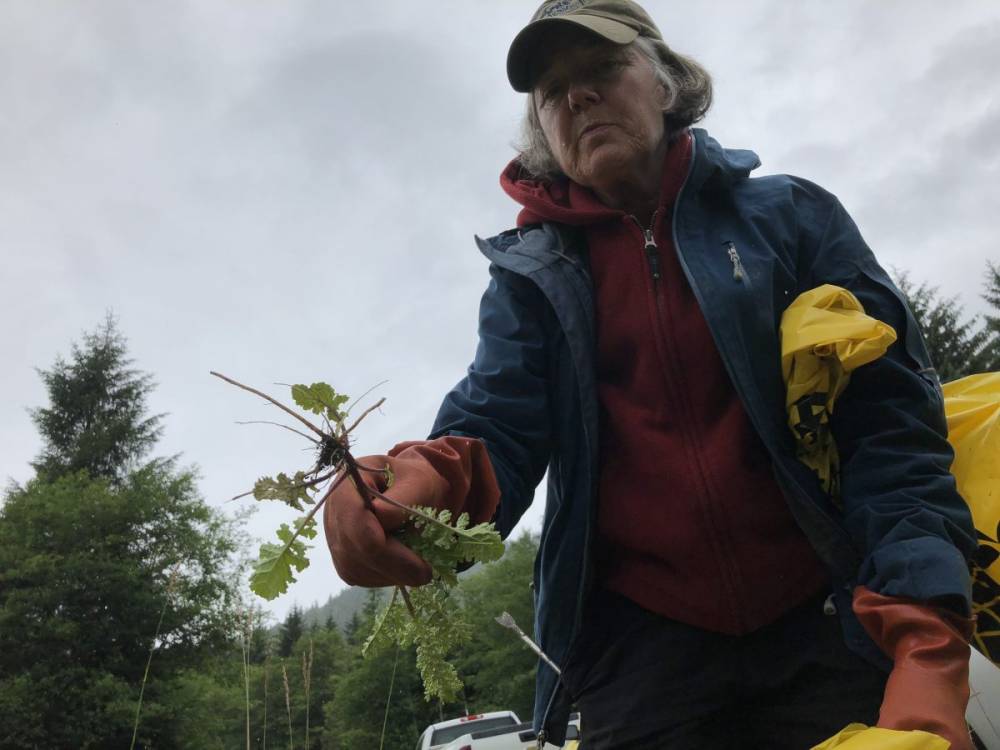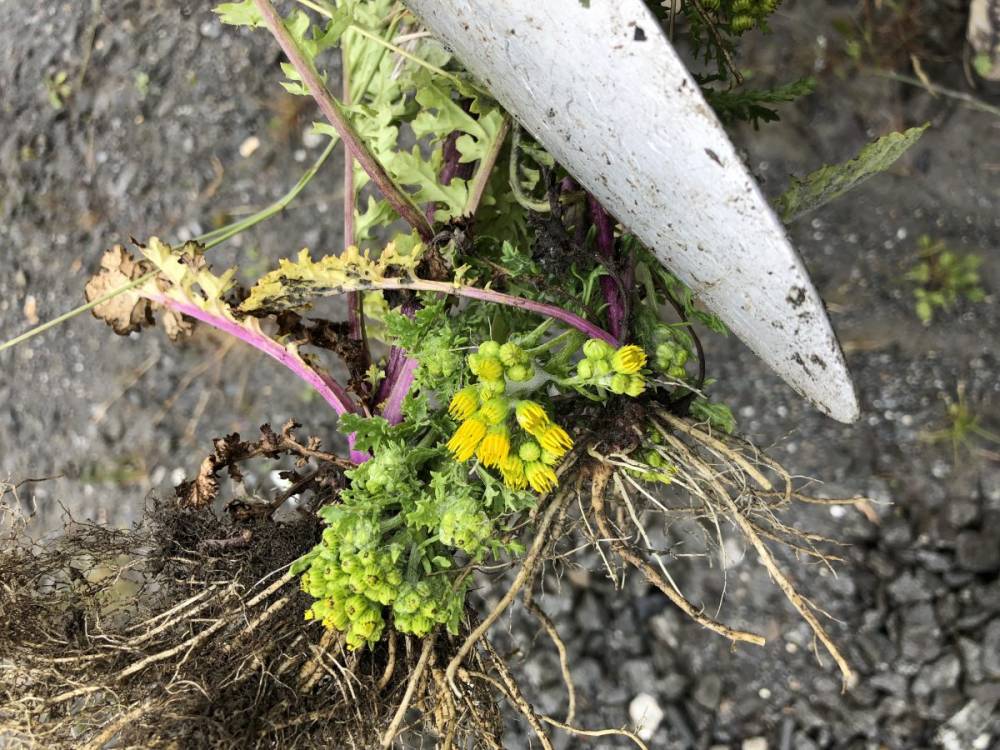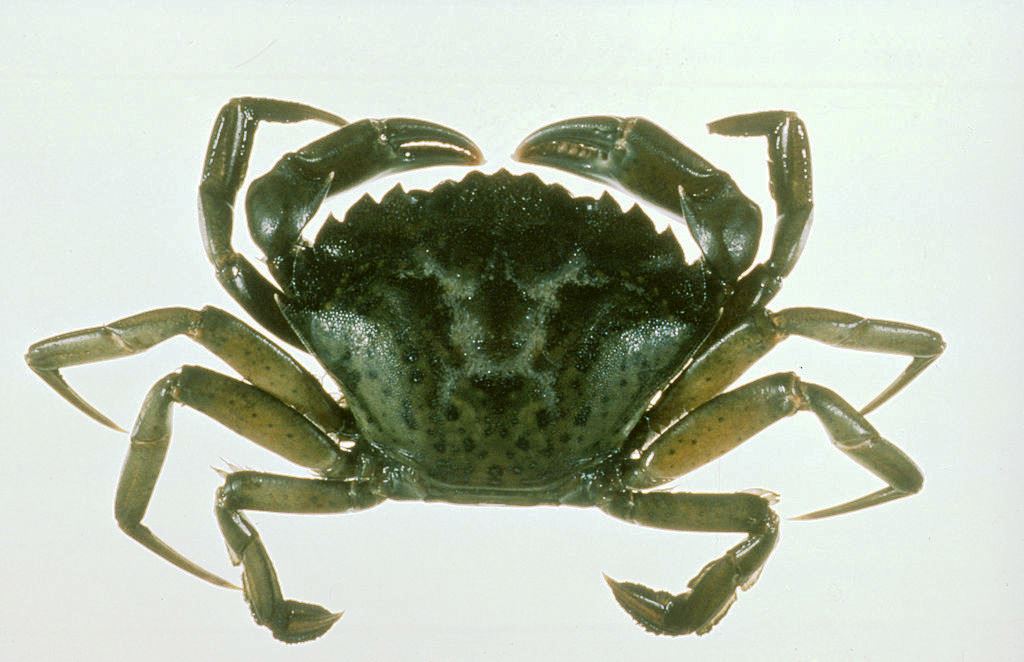
Victoria McDonald holds up a piece of Tansy Ragwort she picked in Ward Cove. (KRBD Photo – Liam Niemeyer)
Across the Lower 48, the U.S. Fish and Wildlife Service estimates hundreds of millions of dollars are spent each year to stop the spread of invasive species. Ketchikan biologists say the isolation and unique climate of Southeast Alaska protects the region from most of those.
But in the coming decades, Southeast Alaska in general can expect more invasive species in the future, potentially hurting local fisheries and native wildlife.
On a recent afternoon in July, Dorica Jackson is on the side of North Tongass Highway in Ward Cove. She’s in a ditch, deep in the weeds. She has gloves on, a small shovel and a focused look. She’s keeping her eyes open for a plant with a specific color.
“We call it the ‘evil yellow,’”Jackson said.
She opens a yellow plastic bag full of green stalks with yellow flowers budding on top.

Dorica Jackson holds a piece of Tansy Ragwort, showing the yellow flowers. (KRBD Photo – Liam Niemeyer)
“This is what I got right in front of the Pioneer Home. I was having lunch with a friend, and she said she saw some in front of the Pioneer Home, so we went and pulled it up.”
This “evil yellow” weed is called Tansy Ragwort, an invasive plant that made its way to Southeast in the ‘90s. Jackson and Victoria McDonald help lead the Cooperative Weed Management Area (CWMA) group in Ketchikan, a volunteer organization that helps pick invasive weeds in the area.
The green stalks and yellow flowers are everywhere in Ward Cove, and McDonald spots them easily.
“You haven’t seen the big areas. Now there’s one — here’s a young guy. Your eye becomes attuned to the plant after a while,” McDonald said.
Tansy Ragwort is considered “evil” by the two because it’s actually toxic. Livestock in the Lower 48 that eat it can die. It can cause a rash if touched by people. And it out-competes native plants like salmonberries.
Jackson remembers reading about tansy ragwort for the first time from a newspaper article in the ‘90s.
“I saw this flower on the side of the road and thought ‘oh isn’t that pretty– oh wait, I think that’s the one I saw in the paper.’ And sure enough, it was,” Jackson said.
What started as a few plants has become fields of the yellow blossoms in Ward Cove. Jackson and McDonald pick thousands of pounds of the weed every year to burn because it spreads so easily.
And in the coming decades, the spread of invasive weeds like Tansy Ragwort and Japanese Knotweed might grow for multiple reasons. Patti Krosse is the Invasive Species Manager for the Tongass National Forest.
She said climate change predictions indicate Southeast will be warmer and wetter in the future. And invasive plants in general adapt better to changing climates.
“Some years, you’ll have really wet climates, some years you’ll have really dry climates. But the thing is about those non-native plants is that they seem really resilient to those changes in particular. So they may end up winning the day, if you will, in regards to those native plants,” Krosse said.
Krosse said along with climate change, disturbance in areas because of new construction and mining also help invasive plants spread. But it takes a combination of these factors for invasive plants to have an advantage.
That means remote rainforest is probably protected. But other places like Prince of Wales Island? Not so much.
“Prince of Wales Island is the number one place. Why? We’ve got lots of roads, we’ve got lots of disturbances going on in terms of extractions of commodities, and we’re going to see within that landscape, and it already is, highly altered.”
Marine invasive species in Southeast are another concern.
Gary Freitag works with the Marine Advisory Program of the University of Alaska-Fairbanks. His problem is the European green crab, an invasive that is marching up the West Coast toward Ketchikan.
“They’ve done more damage on the East Coast to fisheries than about any other invasive species. They’re talking about the shellfish industries in Oregon and Washington have really been hit hard in the order of 50-million-dollar-type of impacts. I expected it two years ago, and I haven’t found any yet,” Freitag said.
Freitag said the European green crab could hurt the shellfish industry in Southeast. A warmer climate in Southeast means warmer waters, and warmer waters could help green crab larvae survive.
“If they can breed, and that is what I mean by the larvae surviving, then you’ve got an issue. You can actually establish colonies, and then they can impact our Dungeness fisheries or our clams.”
Community involvement is crucial in containing invasive species in general, Freitag said. That’s what Dorica Jackson and Victoria McDonald hope to encourage with their efforts.
Jackson plans to keep picking invasive plants until she physically can’t anymore because she simply wants to protect the environment.
“You see one plant along the side of the road, and it’s just one, if you get that, you got the pioneer. And if you get the pioneer, you don’t get a colony. And if you don’t get a colony, you don’t get the town,” Jackson said.







